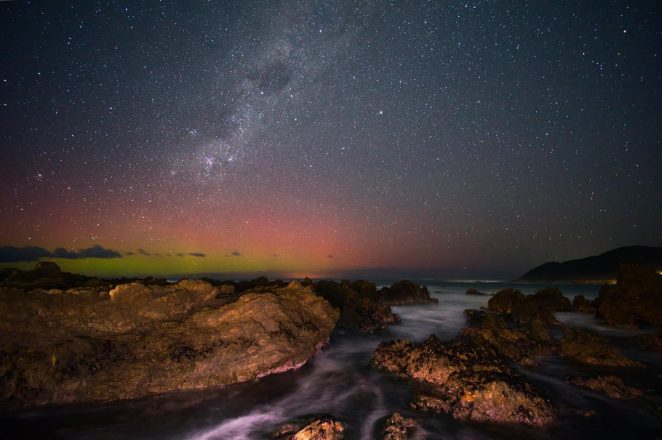오로라 오스트레일리아는 웰링턴의 남부 해안과 해밀턴에서 멋진 사진을 찍었습니다.
크리스 해링턴-라인스는 일요일에 아일랜드 베이에 있는 오쿠 리저브에서 사진을 찍었습니다.그는 그날을 “믿을 수 없는 밤”이라고 불렀고 오후 9시에 앱에서 알림을 받은 후 외출해서 기뻤습니다.그는 거의 두 번이나 포기할 뻔했지만 다시 불이 켜진 새벽 2시까지 머물기로 했다.
제프 응 (Jeff Ng) 도 해안을 따라 조금만 더 가면 오시로 만에서 오로라를 포착할 수 있었습니다.타니아 윌킨슨은 해밀턴에서 사진을 찍으며 이렇게 말했습니다. “해밀턴에서는 오로라를 자주 볼 수 없어요.새벽 3시에는 추웠지만 카메라로 볼 수 있어서 기뻤어요.”그녀는 새벽 3시 30분에 루쿠히아에 있었어요.
남섬에서 스테판 두사우는 서해안의 케이프 파울윈드에서 오로라 사진을 찍었습니다.
오로라 오스트랄리스, 즉 남극광은 태양이 지구의 대기와 상호작용할 때 발생합니다.이는 태양의 입자가 지구 자기장에 부딪혀 “태양 폭풍”이라고도 하는 지자기 폭풍을 일으킬 때 발생합니다.
천문학자 달레이 판타가니 (Daley Pantagani) 에 따르면, “에너지가 공급된 입자가 지구 자기장에 도달하면 극으로 가서 대기 상층의 가스와 만나 하늘에 다채로운 빛을 만들어냅니다.”
북극에 가까운 빛을 오로라 보렐리스라고 하며, 남반구에서는 오로라를 볼 수 있습니다.이따금 북쪽의 오클랜드에서도 남극광을 볼 수 있지만 전문가들은 그럴 가능성이 낮다고 말합니다.
오로라 오스트랄리스는 일 년 중 언제라도 볼 수 있습니다.





























































